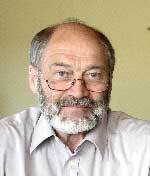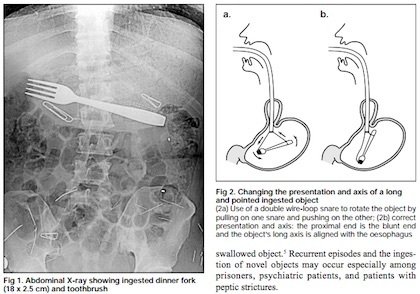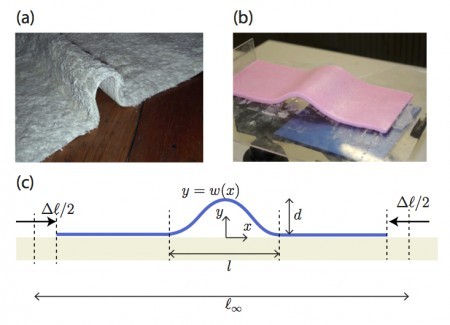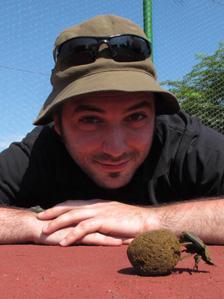Marc Abrahams's Blog, page 311
August 26, 2015
Puritan values: Revised history of Harvard and Yale Universities
Puritan State University tells its own history, and also its own history of two other universities:
Brief History
As were the cases wherein Reverend Harvard founded Harvard University and Rev. Yale, the Yale University in the states, so was Dr. Si Hwa Chang who likewise, as nationalist and a true believer of the Puritan martyr spirit, who founded the first Christian school on 3726 W. Adams Blvd. on this land in the recent dawning era of Koreans in the states….
This Christian school, having commenced as LOS ANGELES BIBLE COLLEGE AND SEMINARY, was approved by the State of California in 1969…. In 1987, the school changed its name to L.A. Christian Univ. and in May 1993 to Puritan State University.

Professor Necker on head-bobbing
 Considerable academic effort has been expended in the ongoing quest to understand head bobbing in birds (see previous article: ‘Why do birds bob their head while running?’) Now, for an expert overview, turn to the work of Professor Necker (University of Bochum [retired]) The professor explains that :
Considerable academic effort has been expended in the ongoing quest to understand head bobbing in birds (see previous article: ‘Why do birds bob their head while running?’) Now, for an expert overview, turn to the work of Professor Necker (University of Bochum [retired]) The professor explains that :
“Altogether it seems that the visual aspect of head-bobbing is the primary function. Head-bobbing may help in improving object detection when foraging on the ground. The coordination of head-bobbing and leg movements is not necessary for keeping balance but may help in stabilizing position during walking. For those birds that practice head-bobbing, both functions seem to be useful adaptations to cope with walking on the ground.”
But, he also notes:
“Although there are now quite a number of observations available, there is still no unequivocal interpretation of the function of head-bobbing and why some birds bob their head and others do not.“
BONUS: The professor has also compiled a unique online resource, in the form of a ‘List of bird species resting on one leg’ along with a photographic library of supporting evidence.

August 25, 2015
Podcast 26: A look back at the 2014 Ig Nobel Prize winners (PART 1)
Trod-upon banana peels; deities in toast; late night psychopaths; cat hazards; dog alignment; really, really, really heavy marijuana users; fat people’s shoes; spearmint tea and hairy women; and someone who swallowed a fork — all these all turn up in this week’s Improbable Research podcast.
Click on the “Venetian blinds” icon — at the lower right corner here — to select whichever week’s episode you want to hear:
SUBSCRIBE on Play.it, iTunes, or Spotify to get a new episode every week, free.
This week, Marc Abrahams tells about:
The 2014 Ig Nobel Prize winners – PART 1. (List of the 2014 Ig Nobel Prize winners, with links to their research. Featuring a dramatic reading by Daniel Rosenberg.) Here’s an illustration from the Ig Nobel Prize-winning study about the slipperiness of banana peels:

Improbable medical research review. (“Heavy Marijuana Users Show Increased Serum Apo-lipo-protein C-III Levels: Evidence from Proteomic Analyses,” S. Jayanthi, S. Buie, S. Moore, R.I. Herning, W. Better, N.M. Wilson, C. Contoreggi, and JL Cadet, Molecular Psychiatry, vol. 15, no. 1 (2010): 101-112. / “Do Overweight People Remove Their Shoes Before Being Weighed by a Doctor? Consecutive Study of Patients in General Practice,” Timothy Harlow, British Medical Journal, 1997, vol. 315, p. 1663. / “Effect of Spearmint (Mentha spicata Labiatae) Teas on Androgen Levels in Women with Hirsutism,” Mehmet Akdoan, Mehmet Numan Tamer, Erkan Cüre, Medine Cumhur Cüre, Banu Kale Körolu, and Namik Deliba, Phytotherapy Research, vol. 21, no. 5 (2007): 444-447. / “Removal of a Dinner Fork From the Stomach by Double-Snare Endoscopic Extraction,” P.T. Yong, C.H. Teh, M. Look , S.B. Wee, J.C. Tan, S.P. Chew, and C.H. Low, Hong Kong Medical Journal, vol. 6, no. 3, September 2000, pp. 319–21. Featuring dramatic readings by Jean Berko Gleason.) Here’s an illustration from the fork study:

The 25th First Annual Ig Nobel Prize ceremony (and webcast).
The mysterious John Schedler perhaps did the sound engineering this week.
The Improbable Research podcast is all about research that makes people LAUGH, then THINK — real research, about anything and everything, from everywhere —research that may be good or bad, important or trivial, valuable or worthless. CBS distributes it, both on the new CBS Play.it web site, and on iTunes and Spotify).

How Do Bumps Form in Carpets?
We’ve all had this experience: we are walking on a carpet, and we suddenly trip over an annoying bump (or “ruck”) that we didn’t know was there. So how did it form?
My colleagues Alpha Lee, Clément Le Goullec, and Dominic Vella from the Mathematical Institute at University of Oxford have just posted a new paper that endeavors to explain an apparent paradox in the formation of carper rucks.
As the authors write in their abstract:
Everyday experience suggests that a ‘ruck’ forms when the two ends of a heavy carpet or rug are brought closer together. Classical analysis, however, shows that the horizontal compressive force needed to create such a ruck should be infinite. We show that this apparent paradox is due to the assumption of inextensibility of the rug. By accounting for a finite extensibility, we show that rucks appear with a finite, non-zero end-shortening and confirm our theoretical results with simple experiments. Finally, we note that the appropriate measure of extensibility, the stretchability, is in this case not determined purely by geometry, but incorporates the mechanics of the sheet.

Figure 1 from the paper by Lee et al.

1997 Ig Nobel Prize winner Sanford Wallace keeps on spamming
Sanford Wallace, who in 1997 was awarded an Ig Nobel Prize for his seminal role in manufacturing and distributing spam, has reportedly been convicted yet again on spam-related legal charges.
The Associated Press reports, on August 25, 2015:
Nevada man pleads guilty to sending spam to Facebook users
A Nevada man pleaded guilty Monday to sending more than 27 million spam messages to Facebook users, federal officials said.
U.S. Attorney Melinda Haag said Sanford Wallace, of Las Vegas admitted in federal court in San Jose, California, to accessing about 500,000 Facebook accounts and sending unsolicited ads disguised as friend posts over a three-month span.
Wallace collected Facebook user account information by sending “phishing” messages that tricked users of the social networking site into providing their passwords, prosecutors said.
He then used that information to log into their accounts and post spam messages on their friends’ Facebook walls, according to the indictment. Those who clicked on the link, thinking it came from a friend, were redirected to websites that paid Wallace for the Internet traffic.
In 2009, Palo Alto-based Facebook sued Wallace under federal anti-spam laws known as CAN-SPAM, prompting a judge to issue a temporary restraining order banning him from using the website.
Wallace, 47, acknowledged accessing Facebook’s computer network in order to send the spam messages on three occasions between November 2008 and February 2009.
Wallace also admitted that he violated a court order not to access Facebook’s computer network. He was charged with fraud and criminal contempt, Haag said.
Wallace is free on bond and scheduled to be sentenced in December. He faces a $250,000 fine and up to three years in prison.
In 2013, Nate Anderson wrote, for Ars Technica, a history of Mr. Wallace’s spam-related achievements:
Sanford Wallace [selfie]
The decade-long quest to stop “Spamford” Wallace
After a spate of lawsuits dating back to the late ’90s, the feds step in…
[He found] monetary success—and public notoriety—during the mid-1990s with his Pennsylvania company Cyber Promotions. As a heavyset twentysomething with close-cropped hair and glasses, Wallace first spammed fax machines and then moved on to e-mail, believing that he had a legal right to market his wares as he saw fit. Dubbed “Spamford” by opponents, he eventually embraced the nickname and even registered the domain spamford.com. (In 1997, Hormel sent him a letter objecting to the name on the grounds that it used the company’s potted meat SPAM trademark). Unlike other spammers who hid their identities, Wallace regularly tangled in public with antispam crusaders.
Cyber Promotions quickly became so hated that a dozen Internet service providers, including AOL, sued Wallace in the late 1990s, each hoping to halt his flood of junk e-mail despite the lack of antispam laws at the time. Wallace pressed on…
The Ig Nobel citation, in 1997, said the Ig Nobel Prize for communications was awarded to “Sanford Wallace, president of Cyber Promotions of Philadelphia — neither rain nor sleet nor dark of night have stayed this self-appointed courier from delivering electronic junk mail to all the world.”
[NOTE: The other, older kind of Spam was the subject of the 1992 Ig Nobel prize for nutrition. That prize was awarded to “The utilizers of Spam, courageous consumers of canned comestibles, for 54 years of undiscriminating digestion.”
Wikipedia provides a handy, if not entirely up-to-date, list of links to documents pertaining to some of Mr. Wallace’s many court proceedings.
BONUS: Monty Python’s tribute to Spam:

August 24, 2015
Dung Beetle insights: The Milky Way, and now the sun
The team that won an Ig Nobel Prize for discovering how dung beetles relate to the Milky Way has now, plus or minus some colleagues, discovered how the those beetles and their cousins relate, also, to the sun.
 They tell about it in a new study: “Neural coding underlying the cue preference for celestial orientation,” Basil el Jundi [pictured here], Eric J. Warrant, Marcus J. Byrne, Lana Khaldy, Emily Baird, Jochen Smolka, and Marie Dacke, Proceedings of the National Academy of Sciences, epub August 24, 2015. The team is based at Lund University, Sweden, and the University of the Witwatersrand, South Africa
They tell about it in a new study: “Neural coding underlying the cue preference for celestial orientation,” Basil el Jundi [pictured here], Eric J. Warrant, Marcus J. Byrne, Lana Khaldy, Emily Baird, Jochen Smolka, and Marie Dacke, Proceedings of the National Academy of Sciences, epub August 24, 2015. The team is based at Lund University, Sweden, and the University of the Witwatersrand, South Africa
The 2013 Ig Nobel Prize for biology and astronomy (a joint category!) was awarded to Marie Dacke, Emily Baird, Marcus Byrne, Clarke Scholtz, and Eric J. Warrant, for discovering that when dung beetles get lost, they can navigate their way home by looking at the Milky Way. They wrote up that research, in this paper: “Dung Beetles Use the Milky Way for Orientation,” Marie Dacke, Emily Baird, Marcus Byrne, Clarke H. Scholtz, Eric J. Warrant, Current Biology, epub January 24, 2013.
Rachel A. Becker describes the new work, in a National Geographic article called “Why Dung Beetles Watch the Sky While Rolling Poop Balls“.
In this video made in 2013, Eric Warrant discusses the dung beetles and the Ig Nobel Prize:
In this video, made earlier that same year, Marie Dacke introduces people to the world od dung beetles and navigation:

Nasal Photography – new directions
“In the frontal view, delicate, 3-dimensional (3D) anatomic structures require special photographic skills. Lighting is crucial for detail rendition and 3D reproduction of the nose, and for apparent photographic bias.”
The observation is provided by authors Benedikt Strub, Konrad Mende, Claudia Meuli-Simmen, and Stephan Bessler in a new paper for the Aesthetic Surgery Journal, entitled: ‘The Frontal View of the Nose: Lighting Effects and Photographic Bias’. The authors experimentally investigated 7 different symmetric and asymmetric lighting techniques to find out which might be preferable in advantageously depicting noses in photographs.
Figure 1.
Schematic of lighting arrangements A, B, and D. (A) Classic “quarter-light arrangement”; (B) “quarter-light arrangement” with an additional light reflector on the patient’s right side; and (D) “quarter-light arrangement” with reduced (2 m) flash-flash distance.
Conclusion:
“In the frontal view, the shape of the nose is strongly influenced by the lighting technique for photographic documentation. The classic symmetric quarter-light arrangement—a commonly applied, practicable, and technically simple lighting technique—has substantial limitations in detail rendition and 3-dimensionality in the frontal view. Asymmetric light greatly improves detail rendition and 3-dimensionality in frontal photographs of the nose, but as we have shown, strongly asymmetric lighting may lead to apparent changes in nasal shape because of increased lateral shadowing leading to photographic bias, depending on the side of illumination. Consequently, documentation of the nose with asymmetric lighting should always be performed in duplicate from both the right and left sides, to prevent misleading interpretations. We found that slightly asymmetric modifications of the classic quarter-light arrangement offer a perfect but time-consuming and technically demanding compromise. A standardized setting with identical lighting conditions is essential for comparable pre- and postoperative photographic assessment of the nose.”

Note: As a courtesy, Improbable has obscured the identity of this participant whose photos are featured in the paper.

August 23, 2015
Terrestrial shrub rover
Justin Shull’s terrestrial shrub rover is pretty much what it’s name says it is. Here’s a video of the device in action. (Thanks to investigator Vaughn Tan for bringing this to our attention.)

August 22, 2015
Fraud, by Alias
Alias had something to say about fraud, and wrote it down:
“Corporate Fraud: An Analysis of Malaysian Securities Commission Enforcement Releases,” Raziah Bi Mohamed Sadique, Jamal Roudaki, Murray B. Clark and Norhayati Alias [pictured here], World Academy of Science, Engineering and Technology, 66, 2010.

August 21, 2015
Revolving Doors (re)visited
The clip shows F1 chief exec. Bernie Ecclestone in an albeit brief encounter with ‘purgatory’.
Purgatory that is, if you follow the work of Professor Siyaves Azeri, from the Department of Philosophy, Mardin Artuklu University, Turkey, who, in a forthcoming paper for the journal Space and Culture, explains how revolving doors might differ from standard hinged doors.
“A classical door, conceptually speaking, signifies a borderline that clearly defines the interior and the exterior of a designated space. With the revolving door, the threshold expands in space; the duration of experiencing the threshold increases in time. The revolving door turns the threshold into an experiential purgatory so that one may claim that the revolving door fetishizes the threshold and makes it into a ‘thing.’ “
‘Evolving Concepts, Revolving Doors’ also notes that :
“The revolving door represents and reconstructs the genetic root of all threshold devices in its full sense: This common genetic root is compartmentalizing the space and segregating different spaces—and most important, the inside and the outside.”
And concludes :
“The swing door determines the threshold as a concrete entity; thus, the inside and the outside are concretely separated; their absoluteness at this stage is a function of their particular concreteness. Such locality signifies a preconceptual stage in the development of the idea of internal and external spaces alongside the public and the private spheres. The revolving door, however, blurs the local-particular concrete divide between the aforementioned spaces. Yet, by abstracting and universalizing the difference between the two, it turns both the interior and the exterior into concrete universals that are synthesized to form their full expression as absolute contradictories in the concrete universality of the threshold that is now extended into a determined space—a purgatory—thanks to the revolving door.”
Previously Improbable also sees (door related):
• Revolving doors – an examination (Laurier #4 of 4)
• Interpreting automatic door motions

Marc Abrahams's Blog
- Marc Abrahams's profile
- 14 followers


![Sanford Wallace [selfie]](https://i.gr-assets.com/images/S/compressed.photo.goodreads.com/hostedimages/1440562448i/15993077.jpg)



